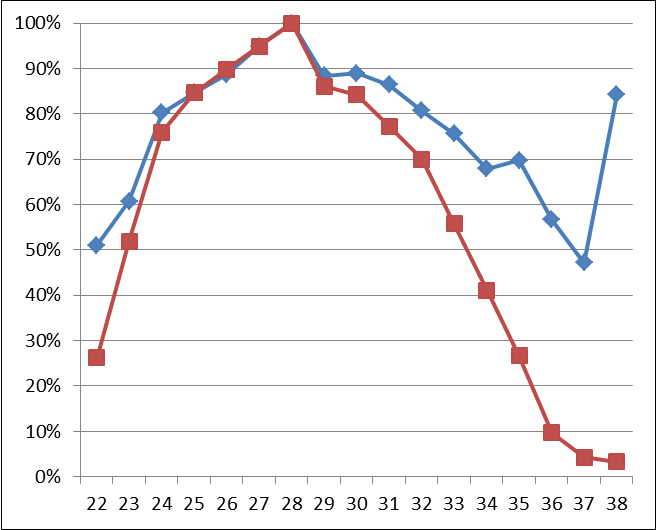A few weeks ago, I discussed why I selected D’Brickashaw Ferguson as my left tackle in the RSP Writer’s Project. In the comments to that post, mrh argued that tackles generally don’t age that well, a proposition I never really considered before. I have previously discussed quarterback age curves and examined running back aging patterns last summer, so I’ve decided to take a closer look at offensive tackles.
First, I grouped together all tackles who entered the league since 1970 and recorded at least four seasons with an Approximate Value of at least 8 points (Ferguson has three seasons with an AV of 8 and two more with an AV of 9). That gave me a group of 78 tackles who were above-average players in their prime. As it turns out, they didn’t age very well as a group, and the results probably underestimate the true effects of age.
As I’ve discussed before, there are two ways to measure group production over a number of a seasons. In the graph below, the red line shows the aging patterns of top tackles when you divide their total AV accumulated by tackles at that age by 78; the blue line shows the age curves when you divide the total AV accumulated only by those tackles active in the NFL at that age.

By both measures, tackles peak at age 28, but then the lines start to diverge. By age 34, only 46 of the 78 tackles were even active; however, of those active players, they were able to sustain much of their production even through age thirty-five. Of course, here “sustain their production” is often a synonym for “earning Pro Bowls” and when it comes to offensive lineman, earning Pro Bowls at age 34 and 35 often have little to do with actual ability. Jeff Saturday made the Pro Bowl in 2012 at age 37 just days before being benched by the Packers.
Ferguson turns 30 in December, which puts him on the wrong side of the age curve. He played well last year, but it would be reasonable to expect a steady decline going forward. In fact, these age curves probably understate the actual effects of age due to the fact that older lineman are more likely to accumulate AV based on reputation, which would bias both the red and blue lines.
The table below shows the data from the graph for those who likes the raw numbers. The AV (act) columns show the AV for only those offensive tackles active in the NFL that year, while the full column represents the aggregate AV divided by 78 regardless of the number of tackles playing.
The Chiefs seem likely to take a left tackle with the first pick in the draft, presumably either Luke Joeckel or Eric Fisher. That’s the case even though Kansas City franchised their current left tackle, Branden Albert, who turns 29 in November. Albert has never made a Pro Bowl and has never posted an AV higher than six in a single season, so I don’t think it’s a stretch to say he is a level or two below the average offensive tackle examined in this study. If that’s the case, we’d expect his dropoff rate to be even sharper. The odds of Albert turning into a perennial Pro Bowl player seem pretty low, and certainly not high enough to make the Chiefs avoid selecting a player six or seven years younger with a much higher ceiling.
